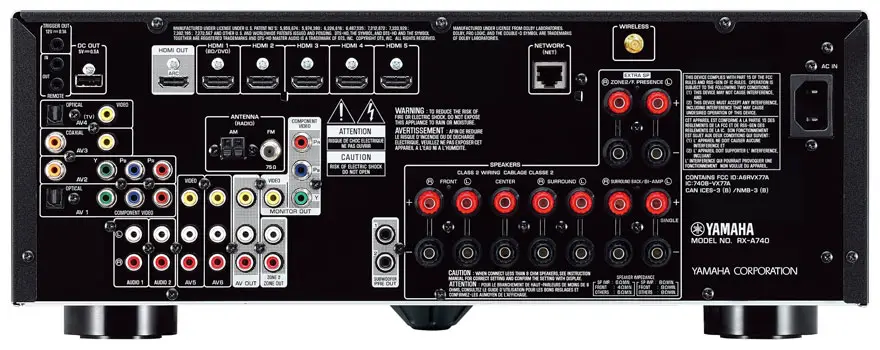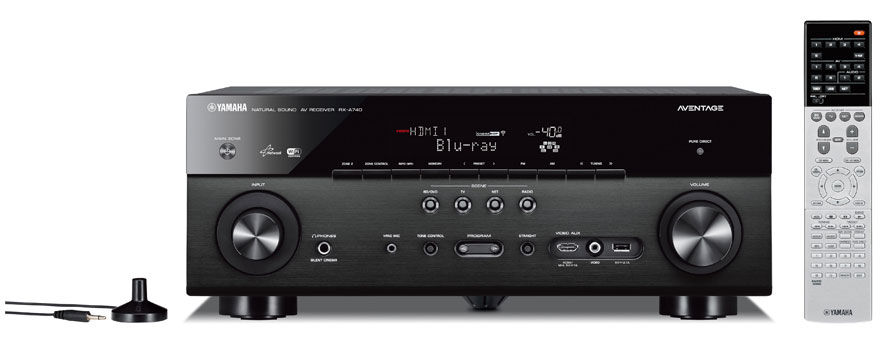Home theater receivers are on a slippery slope these days as high-powered sound bars strive to replace them and a bunch of scattered speakers. The receivers themselves have also reached a tipping point leaving little room for meaningful improvements but the receivers in the entry-level category always have strong potential to grow and stay cheap. Yamaha is doing just that by making the old Yamaha RX-A730 feel like a very outdated product with the release of the Yamaha RX-A740.
Design
The target market of the Yamaha RX-A740 is the same as its predecessor so don’t expect anything more than 6 HDMI inputs (5 rear; 1 front), a single HDMI output and a small selection of legacy inputs on the back. Other than the repositioned Ethernet jack, the added wireless module for the antenna is the biggest leap forward in the RX-A7XX series.
The front of the Yamaha RX-A740 is the same as the RX-A730. The top portion of the receiver sports a smooth black finish that blends nicely with the info display. There is a single row of buttons tied to the usual home theater receiver functions like the tuning, preset and zone controls. The four scene buttons found just below the top row of buttons make a comeback as well offering a quick and convenient way to switch to a particular source like the Blu-Ray player and apply the DSP setting tied to the button all at once. You can configure each scene button to your liking. The input select dial can be a source selection option if you prefer that traditional approach. The front HDMI port found in the Video Aux section supports the MHL standard allowing a wide number of Android smartphones to output HD video and charge. Next to the front HDMI port is a standard video jack and USB port for iPods and other old Apple devices.
Yamaha also continues its use of the Anti-Resonance Technology (A.R.T.). This is Yamaha’s take on dampening the vibrations by placing a fifth foot on the center of the receiver’s base. Unlike the other four feet that support the receiver, this foot has a wedge design for optimal stability. Reducing the vibrations help prevent the audio quality from degrading.
Below is the back panel layout. Click on image to enlarge for a clearer view.

Features
The RX-A740 gets the exact same networking support as the other new AVENTAGE models so those hoping for hassle-free music streaming no longer have to worry about price points. Like a laptop, tablet or smartphone, the Yamaha RX-A740 can connect to a wireless router. Once connected, the receiver opens up several additional functions. If the router has access to the Internet, you can have the receiver directly stream media from several top audio streaming services including Spotify, Pandora, Rhapsody, vTuner and SiriusXM. The RX-A740 can also access various file formats stored in other computers in the same local area network. It has no problem accessing Windows computers and other NAS devices thanks to the DLNA certification. The AirPlay support takes care of the Apple side by allowing computers running iTunes or any modern Apple hardware to easily stream music to the receiver complete with the album art and other metadata. HTC devices uses its own HTC Connect protocol for wireless streaming and the Yamaha RX-A740 supports that as well. Like past models, you still have the option to use the Ethernet port for networking if you require faster speeds.
As with most modern AV receivers these days, iOS and Android smartphones and tablets can operate the RX-A740 remotely through the AV Controller App. Almost everything can be configured from the app’s intuitive interface from the basic speaker settings to the zone management. The neat thing about this feature is that the app doesn’t depend on a router. The Yamaha RX-A740 has a special mode called Wireless Direct that allows a portable device to connect directly to the receiver. You won’t be able to use the Internet streaming features but you can beam music directly to the receiver using the Music Play feature and you can still use the rest of the app for remote control purposes.
The HDMI 2.0 specification is baked in every single HDMI port making the RX-A740 a fine receiver to choose for future-proofing purposes. Many receivers in the past boasted 4K capabilities but the HDMI 2.0 specification is the key ingredient here and it ensures full compatibility with upcoming Ultra HD content complete with 50/60p support. If you are an early adopter of 4K displays, the Yamaha RX-A740 will work well with them and you can even upscale existing 1080p content to 4K so everything looks better on the TV.
One of the advantages of buying a sound bar is the simple setup and clean listening area. Picking a 7.2-channel receiver like the RX-A740 obviously gives you the opportunity to set up your own 5 or 7-speaker layout. But if you really want a clean living room, you can still put all the speakers near your television and have them face the couch. By activating the Virtual CINEMA FRONT feature, these front-facing speakers can still give a pretty convincing surround-sound experience. You can even expand the sound field through the use of CINEMA DSP 3D. If you don’t have any presence speakers, you can still improve the sound of vocals in music videos, movies and TV shows with the Dialogue Lift and Dialogue Level Adjustment feature. Small speakers can benefit from the Yamaha RX-A740 as well. Just turn on the Extra Bass option and the connected subwoofer will pump out better bass while the small speakers balance out the sound nicely.
Making your speaker setup sound its best can be a chore especially if the receiver’s calibration system isn’t very good but the YPAO Reflected Sound Control optimization is a tried and tested Yamaha technology. Once you positioned the microphone to the desired listening area, YPAO does the rest by calibrating the audio parameters and correcting early reflections. YPAO also has a special technology that adds loudness to the EQ setting to make the audio sound clear even if the volume level is low.
Bottom Line
With all AVENTAGE models now equipped with Wi-Fi and full 4K capabilities, picking an AV receiver from the Yamaha family is easier than ever. If you are sure you won’t go beyond 2 zones and 6 HDMI inputs and 90 watts per channel, the Yamaha RX-A740 is a fine pick and it will only set you back $700.
Update: There is a newer model > Yamaha RX-A770
